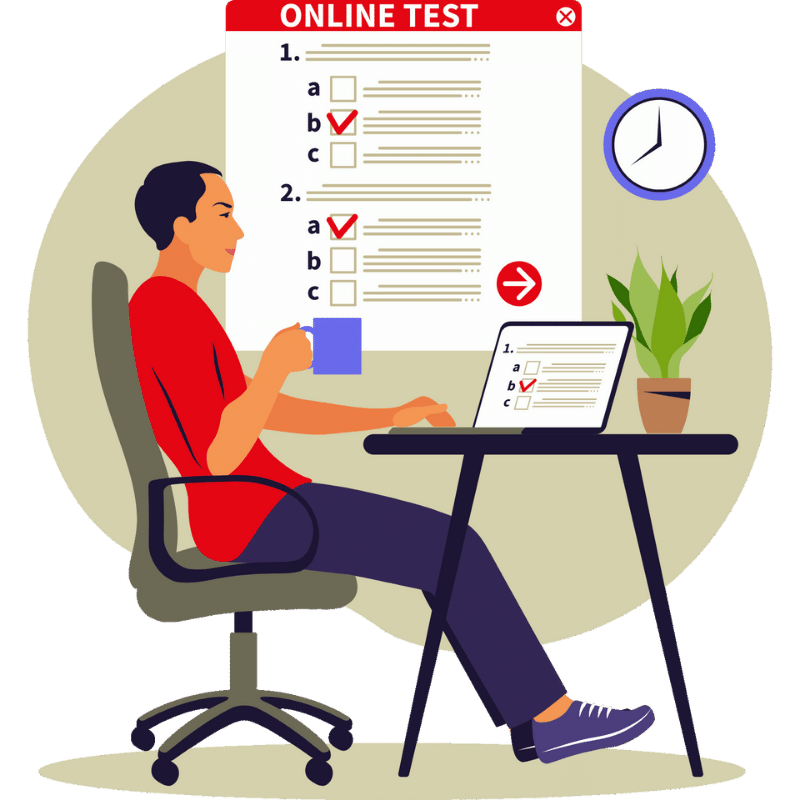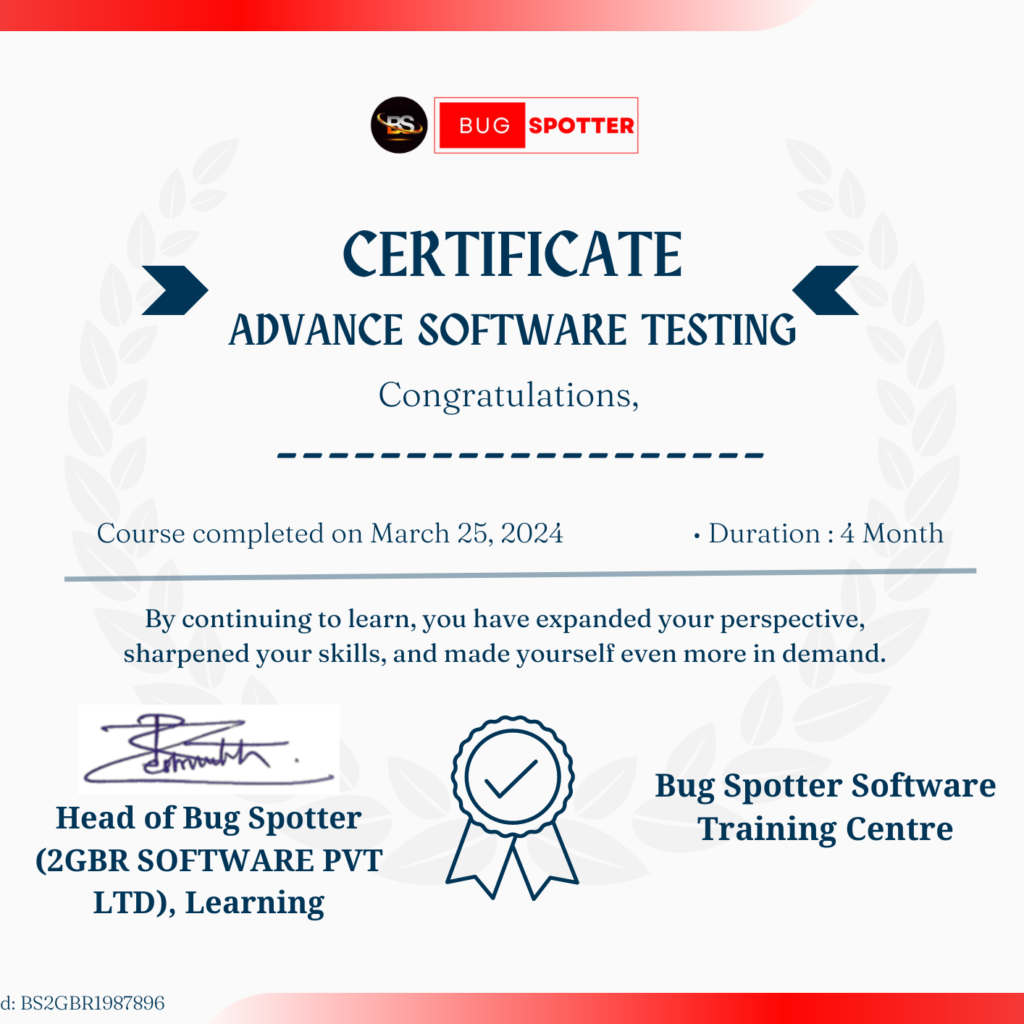Best Software Testing Course In Thane with 100% Placement
100% Placement Assistance | Live Online Sessions
1000+
Students Trained
100%
Placement Assistance
07 December, 2024
Start Date
0%
EMI Available
7:30 AM - 9:30 AM
Lecture Timings ( IST )
Term 1
In this term, you will learn basics of software testing and how to ace Models, Ceremonies,Testing Terminologies, etc…
- Introduction
- Software
- Software Testing
- SQA
- SDLC (Software Development Life Cycle)
- SDLC Models:
- Fish Model
- Waterfall Model
- V-Model
- Agile Model
- Agile Ceremonies:
- Daily Scrum Meeting
- Backlog Grooming Meeting
- Sprint Planning Meeting
- Sprint Retrospective Meeting
- Functional Testing
- Non-Functional Testing
- UAT Testing
- Priority & Severity
- Testing Terminologies
Term 2
In this term, you will learn how to ace Test Plans, Methodologies, Tools, etc…
Module 2: Advanced Part
- Test Plan
- Test Methodology
- STLC (Software Testing Life Cycle)
- Bug Life Cycle
- Test Case Design
- Bug Tracking Tool: JIRA
- Accessibility Testing Tool: NVDA
- Performance Testing Tool: J-Meter
- Mobile Testing
- Real Time Interview Questions
Basic of SQL :
- Downloading & Installation of Oracle
- Data Base
- DML Commands
- DDL Commands
- SQL Constrains
- Aggregate Functions
- SQL JOINS
Term 3
In this term, you will learn how to ace Api testing and industry projects
Module 4
Basic :
- Idea of API & API Testing
- Basic Idea of POSTMAN Tool
HTTP Methods :
- GET
- POST
- PUT
- PATCH
- DELETE
HTTP Status Codes :
Practical Demo of API Testing :
Module 5: Core Java
- Basics of Java:
- What is Java
- Data Type
- Variable
- Operators
- Control Statement:
- Conditional Statement
- Jump Statement
- Looping Statement
- Methods (Functions)
- Constructors
- OOPS Concept:
- Inheritance
- Polymorphism
- Encapsulation
- Abstraction
- Access Modifiers
- Advanced Part:
- String Class & Its Methods
- Array
- Collection
- Logical Program
- Pattern Program
Module 6: Selenium WebDriver
- Basics of Selenium WebDriver:
- What is Selenium?
- Introduction to Selenium and Automation Testing
- Selenium Architecture
- How to Download and Install Selenium WebDriver
- What is WebDriver and WebElement and Its Methods?
- First Automation Script
- Locators in Selenium
- XPath Locators and Its Types
- FindElement() and FindElements() Methods
Module 7: Framework and DevOps
- Actions on WebElement and TestNG:
- How to Select DropDown from Selenium WebDriver
- How to Take Screenshot in Selenium WebDriver
- Actions Class in Selenium
- Selenium Waits
- Popup Handling in Selenium
- How to Handle Iframe
- Read and Write Excel Data
- How to Download and Install TestNG
- TestNG Annotations, Keywords
- Cross Browser Testing
- TestNG Groups - Include and Exclude with Example
- xml and Reports
- Page Object Model
- Maven
- BDD Framework
- Git, GitHub
- Jenkins
- Banking Domain
- Telecom Domain
- E-Commerce Domain
- Healthcare Domain
- Technical Doubt Sessions
- Non Technical Doubt Sessions
- Resume Building
- Placement Process
Why software testing course in Bug Spotter?

Daily Doubt Sessions

Daily Mock Tests

Weekly Mock Interview

Alumni Guidence

Resume Preparation

Job Assistance

Expert Trainers

Self Paced Learning

Students Felicitations
Benefits of Our Software Testing Course Certification:
Our certification is recognized by top companies like Capgemini, Infosys, TCS, and Tech Mahindra, giving you a significant advantage in the job market. Here’s how it helps:
Key Benefits:
- Industry Recognition: Get noticed by leading IT companies.
- Career Growth: Improve your chances of landing better job opportunities.
- Skill Validation: Prove your expertise and stay competitive in the field.
- Higher Salary: Certified professionals are often offered better pay and promotions.
- Networking: Connect with a community of professionals and expand your career network.
- Increased Confidence: Gain confidence in your skills, knowing they are recognized by the industry.
Be Certified

Step-by-Step Preparation for Software Testing
Step 1: Start with Manual Testing
Begin with manual testing to understand the basics of the software testing process. Focus on writing test cases, executing them, and reporting bugs. Also, practice SQL for database testing and learn RESTful API testing
Duration: 1.5 months.
Step 2: Learn Core Java Basics
Once you’re comfortable with manual testing, start learning Core Java. Java is essential for automation testing, especially with tools like Selenium, and it helps you understand object-oriented programming (OOP) concepts.
Step 3: Begin Selenium Automation Testing
After covering Java basics, start learning Selenium to automate web testing. Continue to practice Java and OOP alongside Selenium for a stronger foundation in automation.
Duration: 1.5 months.
Step 4: Wrap Up Learning in 3 Months
In total, spend around 3 months to cover manual testing (including SQL and API) and automation testing (Java and Selenium). By this point, you’ll have the skills for both manual and automated testing.
Step 5: Work on a Real-World Project
Apply your skills in a project involving both manual and automated testing. This will give you practical experience and enhance your portfolio, preparing you for real-world testing roles.

What is automation testing, and how does it differ from manual testing?
Automation testing involves using specialized tools and scripts to execute tests automatically, which allows for faster, more consistent, and repetitive testing without manual intervention. It is especially useful for tasks that need to be run frequently or require large amounts of data. In contrast, manual testing relies on human testers to execute test cases step by step, which can be slower and more prone to human error. While automation testing requires an initial investment in tools and script development, it ultimately saves time and reduces costs in the long run, especially for repetitive tasks. Manual testing, however, is better suited for exploratory testing or situations where human judgment is required.
why software testing is important?
Software testing is important because it helps find problems or bugs in the code before the product is released to customers. This step is crucial for improving the product’s quality, which directly impacts customer satisfaction and interest. Delivering a high-quality product is a key factor in achieving success.
What is the role of data-driven testing in automation, and how is it implemented?
Data-driven testing in automation involves running the same test script with multiple sets of input data to validate different conditions and ensure the software handles various scenarios correctly. The test script is separated from the test data, which is typically stored in external files (like Excel, CSV, or databases). During execution, the test reads the input data, performs actions based on that data, and checks the results, allowing for more comprehensive test coverage. It helps to efficiently test applications with varying inputs without having to write multiple scripts. Data-driven testing is implemented by using automation frameworks like Selenium or TestNG, which support reading and passing data dynamically to test scripts, ensuring better scalability and maintainability of tests.
What is automation testing Course?
Popular software testing tools include Selenium and Appium for automation testing, JUnit and TestNG for unit testing, and Cucumber for behavior-driven development (BDD). Jira is widely used for project management, MySQL for database testing, Postman for API testing, and Eclipse serves as a popular integrated development environment (IDE).
What are the advantages of automation testing in software development?
Automation testing offers several advantages in software development, including faster execution of tests, which speeds up the overall development cycle. It ensures consistent and repeatable test results, reduces human error, and allows for more comprehensive testing, especially for regression and repetitive tests. Automation also increases test coverage, supports continuous integration and delivery, and helps identify bugs early, ultimately improving the quality of the software while saving time and costs in the long term.
What is Selenium, and how is it used in automation testing?
Selenium is an open-source, widely used framework for automating web applications across different browsers and platforms. It allows testers to write test scripts in various programming languages such as Java, Python, C#, and JavaScript. Selenium can simulate user interactions with a web browser (like clicking buttons, filling forms, and navigating pages) to verify that the web application behaves as expected. It supports different browsers (e.g., Chrome, Firefox, Safari) and integrates with tools like TestNG or JUnit for test management. Selenium is highly effective for automating repetitive testing tasks, improving efficiency, and ensuring consistent test execution.
Job Roles After Completing a Software Testing Course
- Manual Tester: Tests software manually to identify bugs.
- Automation Tester: Uses tools like Selenium to automate test cases.
- Test Engineer: Designs and executes test plans and scripts.
- Quality Assurance (QA) Analyst: Ensures overall software quality.
- Performance Tester: Tests software performance under load and stress.
- API Tester: Tests the functionality of APIs.
- Security Tester: Focuses on finding security vulnerabilities in software.
- Test Lead/Manager: Manages the testing team and ensures testing processes are followed.
- Continuous Integration (CI) Tester: Works with CI tools to test software frequently.
- Test Automation Architect: Designs automated testing strategies for complex projects.
Software Testing Salary in India
| Role | Average Salary (INR) | Salary Range (INR) |
|---|---|---|
| Software Tester | ₹5,25,000 | ₹3,56,000 - ₹8,75,000 |
| Software Test Engineer | ₹6,50,000 | ₹4,23,500 - ₹9,54,000 |
| Test Lead/Manager | ₹9,00,000 | ₹6,50,000 - ₹12,00,000 |
| Automation Tester | ₹6,00,000 | ₹4,00,000 - ₹8,00,000 |


